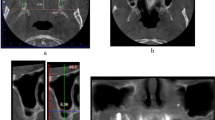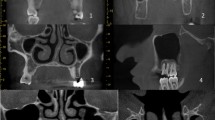Abstract
Objective
Understanding of maxillary sinus hypoplasia (MSH) and associated sinonasal variants is paramount to the diagnostic and therapeutic success of maxillary sinus and maxillary dental implant surgery. The purpose of this work was to explore the prevalence of MSH, frequency of mucosal thickening, and anatomical variations in the sinonasal complex.
Methods
Retrospective case-control design based on cone beam CT images of dental patients with MSH and matched for age and gender. MSH type and sinonasal variables were recorded.
Results
One thousand three hundred seventy cone beam CT scans were analyzed for MSH. MSH prevalence was 6% (n=82), matched with 82 controls= 100 females and 64 males, mean age 37.1±14.1 years. Most MSH were type I, 69.5%, 80.5% unilateral, 65.9% associated with no or mild mucosal thickening. Associated sinonasal anatomical variations were <27% except for deviated/hyperplastic (DH) meatus, 48.8%. Within the MSH group, significant associations were presented between MSH type, mucosal thickening, and DH nasal meatus. MSH group vs controls showed a significant difference in mucosal thickening (OR 5.2, 95% CI 2.0–17.3) and DH meatus (OR 1.6, 95% CI 1.4–2.1).
Conclusions
A hypoplastic maxillary sinus with abnormal or absent uncinate process is associated with advanced mucosal thickening and may present with altered anatomy of the lateral wall of the nasal cavity causing its approximation to the orbital floor.
Clinical relevance
Pre-surgical knowledge of altered anatomy in the sinonasal complex is crucial in dental implant or sinus surgery.





Similar content being viewed by others
References
Wake M, Shankar L, Hawke M, Takeno S (1993) Maxillary sinus hypoplasia, embryology, and radiology. Arch Otolaryngol Head Neck Surg 119:1353–1357
Sánchez Fernández JM, Anta Escuredo JA, Sánchez Del Rey A, Santaolalla Montoya F (2000) Morphometric study of the paranasal sinuses in normal and pathological conditions. Acta Oto-Laryngol 120:273–278
Erdem T, Aktas D, Erdem G, Mimam MC, Ozturan O (2002) Maxillary sinus hypoplasia. Rhinology 40:150–153
Bhargava A, Khanduri S, Shakeel M, Srivastava S, Varshney P (2016) Maxillary sinus hypoplasia—a not-so-uncommon clinical entity: a review. Clin Rhinol 9:43–45
Hall GM (1969) Embryology and abnormal anatomy of the maxillary sinus. Northwest Med 68:1010–1011
Wasson w (1933) Changes in the nasal accessory sinuses after birth. JAMA Otolaryngology Head & Neck Surgery 17:197–211
Moss ML (1997) The functional matrix hypothesis revisited. 3. The genomic thesis. American Journal of Orthodontics and Dentofacial Orthopedics 112:338–342
Bolger WE, Woodruff WW Jr, Morehead J, Parsons DS (1990) Maxillary sinus hypoplasia: classification and description of associated uncinate process hypoplasia. Otolaryngol Head Neck Surg 103:759–765
Ata-Ali J, Diago-Vilalta J, Melo M, Bagán L, Soldini M, Di-Nardo C, Ata-Ali F, Mañes-Ferrer J (2017) What is the frequency of anatomical variations and pathological findings in maxillary sinuses among patients subjected to maxillofacial cone beam computed tomography? A systematic review. Med Oral Patol Oral Cir Bucal 22:e400–e409
Al-Rawi NH, Uthman AT, Abdulhameed E, Al Nuaimi AS, Seraj Z (2019) Concha bullosa, nasal septal deviation, and their impacts on maxillary sinus volume among Emirati people: a cone-beam computed tomography study. Imaging Sci Dent 49:45–51
Anbiaee N, Khodabakhsh R, Bagherpour A (2019) Relationship between anatomical variations of sinonasal area and maxillary sinus pneumatization. Iran J Otorhinolaryngol 31:229–234
Demirel O, Ucok CO, Alkurt MT (2017) Evaluation of osteomeatal complex anomalies and maxillary sinus diseases using cone beam computed tomography. Current Medical Imaging Reviews 13:397–405
Göçmen G, Borahan MO, Aktop S, Dumlu A, Pekiner FN, Göker K (2015) Effect of septal deviation, concha bullosa and Haller’s cell on maxillary sinus’s inferior pneumatization; a retrospective study. Open Dent J 9:282–286
Kalabalik F, Tarim Ertas E (2019) Investigation of maxillary sinus volume relationships with nasal septal deviation, concha bullosa, and impacted or missing teeth using cone-beam computed tomography. Oral Radiol 35:287–295
Mahajan A, Mahajan A, Gupta K, Verma P, Lalit M (2010) Anatomical variations of accessory maxillary sinus ostium: an endoscopic study. Int J Dent 2010
Shpilberg KA, Daniel SC, Doshi AH, Lawson W, Som PM (2015) CT of anatomic variants of the paranasal sinuses and nasal cavity: poor correlation with radiologically significant rhinosinusitis but importance in surgical planning. Am J Roentgenol 204:1255–1260
Smith KD, Edwards PC, Saini TS, Norton NS (2010) The prevalence of concha bullosa and nasal septal deviation and their relationship to maxillary sinusitis by volumetric tomography. Int J Dent 2010:10.1155/2010/404982.
Yilmaz SY (2014) A diagnosis of maxillary sinus fracture with cone-beam CT: case report and literature review. Craniomaxillofac Trauma Reconstr 7:85–91
Ginat DT (2015) Posttreatment imaging of the paranasal sinuses following endoscopic sinus surgery. Neuroimaging Clin N Am. 25:653–665
Zeifer B (2002) Sinusitis: postoperative changes and surgical complications. Semin Ultrasound CT MR. 23:475–491
Lund VJ, Mackay IS (1993) Staging in rhinosinusitus. Rhinology 31:183–184
Benjamini Y, Hochberg Y (1995) Controlling the false discovery rate: a practical and powerful approach to multiple testing. Journal of the Royal Statistical Society. Series B (Methodological) 57:289–300
Faul F, Erdfelder E, Buchner A, Lang A (2009) Statistical power analyses using G*Power 3.1: tests for correlation and regression analyses. Behavior Research Methods 41:1149–1160
Sirikçi A, Bayazit Y, Gumusburun E, Bayram M, Kanlikana M (2001) A new approach to the classification of maxillary sinus hypoplasia with relevant clinical implications. Surg Radiol Anat 22:243–247
Brandt MG, Wright ED (2008) The silent sinus syndrome is a form of chronic maxillary atelectasis: a systematic review of all reported cases. Am J Rhinol 22:68–73
Numa WA, Desai U, Gold DR, Heher KL, Annino DJ (2005) Silent sinus syndrome: a case presentation and comprehensive review of all 84 reported cases. Ann Otol Rhinol Laryngol 114:688–694
Kantarci M, Karasen RM, Alper F, Onbas O, Okur A, Karaman A (2004) Remarkable anatomic variations in paranasal sinus region and their clinical importance. Eur J Radiol 50:296–302
Price DL, Friedman O (2007) Facial asymmetry in maxillary sinus hypoplasia. Int J Pediatr Otorhinolaryngol 71:1627–1630
Salib RJ, Chaudri SA, Rockley TJ (2001) Sinusitis in the hypoplastic maxillary antrum: the crucial role of radiology in diagnosis and management. J Laryngol Otol 115:676–678
Dykewicz MS, Hamilos DL (2010) Rhinitis and sinusitis. J Allergy Clin Immunol 125:S103–S115
Kapusuz Gencer Z, Ozkiris M, Okur A, Karaçavus S, Saydam L (2013) The effect of nasal septal deviation on maxillary sinus volumes and development of maxillary sinusitis. Eur Arch Otorhinolaryngol 270:3069–3073
Karatas D, Koç A, Yüksel F, Dogan M, Bayram A, Cihan MC (2015) The effect of nasal septal deviation on frontal and maxillary sinus volumes and development of sinusitis. J Craniofac Surg 26:1508–1512
Kucybala I, Janik KA, Ciuk S, Storman D, Urbanik A (2017) Nasal septal deviation and concha bullosa - do they have an impact on maxillary sinus volumes and prevalence of maxillary sinusitis? Pol J Radiol 82:126–133
Orhan I, Ormeci T, Aydin S, Altin G, Urger E, Soylu E, Yilmaz F (2014) Morphometric analysis of the maxillary sinus in patients with nasal septum deviation. Eur Arch Oto-Rhino-Laryngol 271:727–732
Glasier CM, Mallory GB Jr, Steele RW (1989) Significance of opacification of the maxillary and ethmoid sinuses in infants. J Pediatr 114:45–50
Severt TR, Proffit WR (1997) The prevalence of facial asymmetry in the dentofacial deformities population at the university of north carolina. Int J Adult Orthodon Orthognath Surg. 12:171–176
Selcuk A, Ozcan KM, Akdogan O, Bilal N, Dere H (2008) Variations of maxillary sinus and accompanying anatomical and pathological structures. J Craniofac Surg 19:159–164
Author information
Authors and Affiliations
Corresponding author
Ethics declarations
Ethics approval
Ethical approval for this project was granted by Health Research Ethics Board, Health Panel, University of Alberta, Edmonton, Canada. “All procedures performed in studies involving human participants were in accordance with the ethical standards of the institutional and/or national research committee and with the 1964 Helsinki declaration and its later amendments or comparable ethical standards.”
Informed consent
For this type of study, formal consent is not required.
Conflict of interest
The authors declare no competing interests.
Additional information
Publisher’s note
Springer Nature remains neutral with regard to jurisdictional claims in published maps and institutional affiliations.
Rights and permissions
About this article
Cite this article
Alsufyani, N., El-Hakim, H. & Major, P. Prevalence of maxillary sinus hypoplasia and association with variations in the sinonasal complex: a cone beam CT study. Clin Oral Invest 25, 5463–5471 (2021). https://doi.org/10.1007/s00784-021-03854-3
Received:
Accepted:
Published:
Issue Date:
DOI: https://doi.org/10.1007/s00784-021-03854-3




